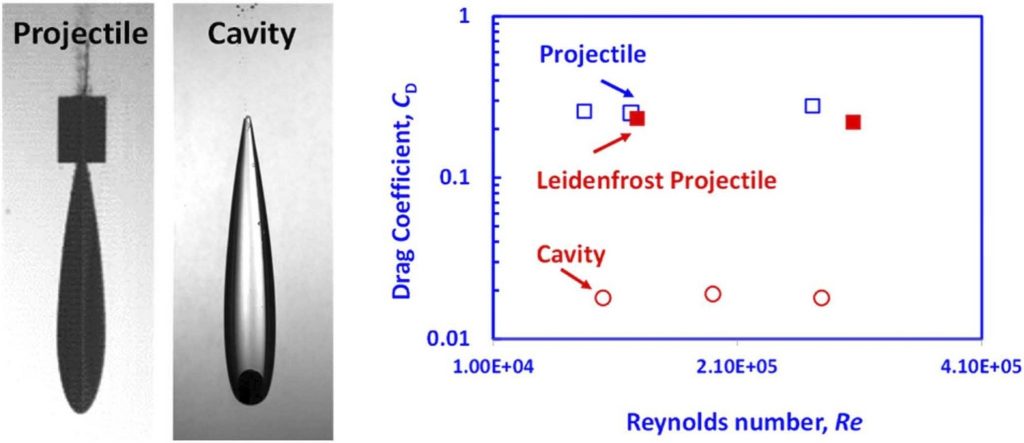Filters
Research output of DCPE
Tiny-TIM intestinal fluids versus human intestinal fluids: A comparison of their composition and solubilizing capacity for poorly soluble drugs
Eur. J. Pharm. Sci. 2025, 211, 107150
The tiny-TIM system offers an in vitro platform for the simulation of physiological processes occurring in human stomach and small intestine aiding in drug product development by predicting the bioperformance of oral formulations under fasted and fed state intake conditions. To assess this in vitro system in terms of its physiological relevance, we performed a detailed analysis of the composition as well as the solubilizing capacity of tiny-TIM intestinal fluids (TIF), and compared this to previously collected and analysed human intestinal fluids (HIF). Moreover, the impact of meal type on TIF composition and solubilising capacity was investigated by using either a liquid meal or a solid meal. In the fasted state, TIF exhibited lower lipid concentrations with a TIF/HIF ratio of 0.27, and elevated bile salt levels (TIF/HIF ratio of 1.8). Fasted state TIF generally overpredicted the solubilizing capacity of HIF, likely due to its higher bile salt concentrations. In the fed state, TIF contained biorelevant lipid concentrations but remained monophasic without phase separation, unlike HIF. This was likely due to higher bile salt levels (5.3 times that of HIF), which solubilized all lipids into the micellar phase. This resulted on average in a 3.3-fold increase in solubility of the poorly water-soluble model compounds in the micellar fraction of TIF as compared to HIF. Shifting from a liquid to a solid meal had minimal impact on TIF composition and solubilizing capacity.
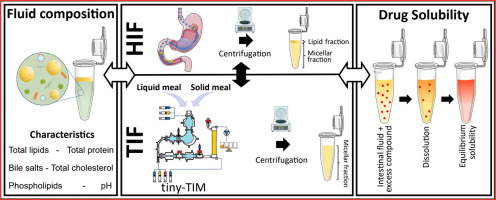
Intraluminal enzymatic hydrolysis of API and lipid or polymeric excipients
Int. J. Pharm. 2025, 675, 125489
The role of intraluminal enzymes for the hydrolysis of active pharmaceutical ingredients (API), prodrugs and pharmaceutical excipients will be reviewed. Carboxylesterases may hydrolyze ester-based API, prodrugs and ester-bond containing polymer excipients, whereas lipases digest lipid formulation excipients, such as mono-, di- and triglycerides. To clarify the conditions that should be mimicked when designing in vitro studies, we briefly review the upper gastrointestinal physiology and provide new data on the inter-individual variability of enzyme activities in human intestinal fluids. Afterwards, the methodology for studying enzymatic hydrolysis of API, prodrugs, lipid and polymeric excipients, as well as the main results that have been obtained, are summarized. In vitro digestion models used to characterize lipid formulations are well described, but data about the hydrolysis of lipid excipients (including surfactants) has been scarce and contradictory. Data on API and prodrug hydrolysis by esterases is available; however, inconsistent use of enzyme types and concentrations limits structure-stability relationships. Hydrolysis of polymer excipients in the lumen has not been significantly explored, with only qualitative data available for cellulose derivates, polyesters, starches, etc. Harmonization of the methodology is required in order to curate larger enzymatic hydrolysis datasets, which will enable mechanistic understanding and theoretical prediction.
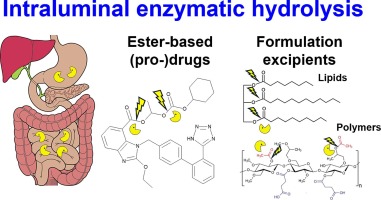
Cosmetic potential of haberlea rhodopensis extracts and extracellular vesicles in human fibroblast cells
Cosmetics 2025, 12, 90
Skin ageing is a complex biological process influenced by cellular senescence, oxidative stress, and extracellular matrix degradation. Emerging evidence suggests that plant-derived bioactive compounds and extracellular vesicles (EVs) play a crucial role in modulating cellular homeostasis, promoting tissue regeneration, and counteracting age-related morphological and functional changes. This study investigates the impact of Haberlea rhodopensis in vitro culture extracts, native and enriched with EVs, on key cellular processes, including morphology, mitochondrial dynamics, lysosomal activity, gene expression, and genotoxicity in human dermal fibroblasts. The extracellular vesicles were identified in terms of shape, size, and morphology using dynamic light scattering, negative staining and observation under a transmission electron microscope. A comprehensive in vitro analysis was conducted utilizing light microscopy to assess cellular morphology and lysosomal mass, fluorescence microscopy for actin cytoskeletal organization, mitochondrial integrity, and nuclear morphology, and gene expression profiling for markers associated with collagen synthesis (COL1A1, COL3A1), senescence (CDKN1A), and oxidative stress response (NFE2L2). Additionally, cell cycle progression was evaluated, and genotoxicity was assessed using the neutral comet assay. Haberlea rhodopensis in vitro culture extracts and EVs were found to preserve fibroblast morphology, enhance mitochondrial mass, and upregulate collagen-related gene expression. These effects were concentration-dependent. The extracts exhibited biocompatibility with minimal genotoxic effects, indicating their potential as safe bioactive agents for skin rejuvenation. The findings suggest that Haberlea rhodopensis in vitro culture extracts and their enrichment with extracellular vesicles hold promise for cosmetic and dermatological applications, particularly in enhancing collagen production, preserving cellular integrity, and mitigating age-related alterations in skin fibroblasts. Further studies are warranted to elucidate the underlying molecular mechanisms and optimize formulation strategies for clinical translation.
Cleansing mechanisms and efficacy on artificial skin
Molecules 2025, 30, 1813
A systematic study on the mechanisms of cleansing artificial skin by solutions of widely used in personal care surfactants disodium laureth sulfosuccinate (DSLSS), sodium laureth sulfate (SLES), sodium dodecyl sulfate (SDS), dodecyl trimethyl ammonium bromide (DTAB), and coco glucoside (CG), is presented. The systematic characterization of soil removal from artificial skin revealed two primary cleansing mechanisms: emulsification and roll-up. Emulsification occurs in systems with very low interfacial tension, such as sebum in SLES solutions, while dimethicone soil was only removed by roll-up. The roll-up effectiveness depends on the surfactant’s interfacial activity and its adsorption on the soiled surface. Thus, the strong adsorption of DTAB on the skin leads to dimethicone roll-up at a relatively high interfacial tension of 11 mN/m. The anionic and nonionic surfactants adsorbed less at the artificial skin surface, and the oil/water interfacial tension value lowering below 5 mN/m is necessary for the roll-up to occur. Nonionic CG removed dimethicone at a lower concentration than ionic surfactants. Combining CG with ionic surfactants improved cleaning at lower total concentrations. Surfactant mixtures are used to formulate simple cleansing formulations, whose performance is also investigated by the developed in vitro approach. The results obtained allow for a good rating of the formulations, which correlates well with the performance of the surfactant mixtures and their interfacial activity.
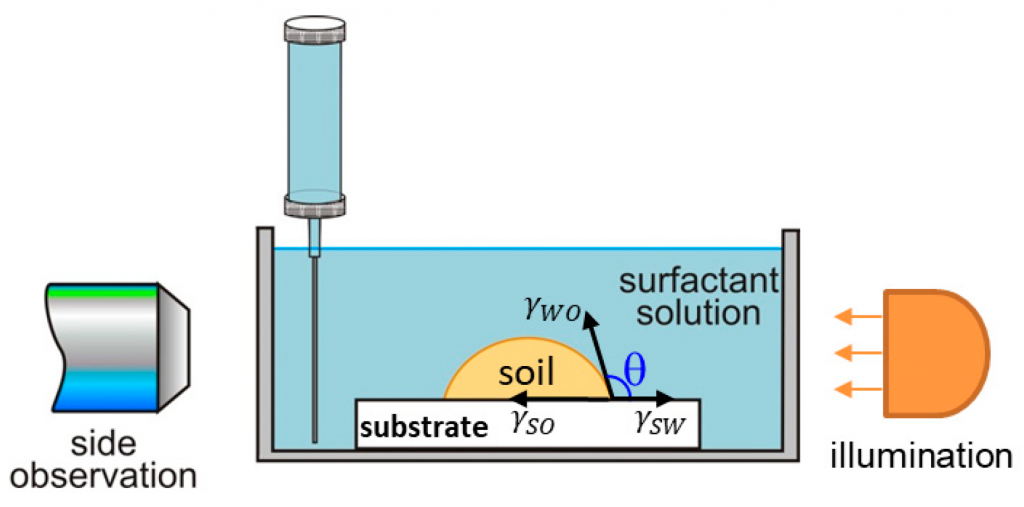
Quantitative characterization of the mass transfer of volatile amphiphiles between vapor and aqueous phases: Experiment vs theory
JCIS Open 2025, 18, 100133
The class of volatiles, which possess low saturated vapor pressures, appreciable solubilities in water, and well pronounced surface activities, have gained wide applications in diverse areas of industry, cosmetics, and medicine. One way to qualitatively characterize their mass transfer between vapor and aqueous solutions is to measure the relaxation of the interfacial tension, σ, with time, t, under different nonequilibrium initial conditions. This approach is applied in the present work for geraniol and menthol. By means of combining σ(t) data with the respective equilibrium surface tension isotherms, the instantaneous values of the fragrance adsorption, Γ(t), have been determined. Quantitative characterization of the geraniol and menthol mass transfers in the case of adsorption from vapor to aqueous drops is achieved by using a mixed barrier-diffusion model. The obtained values of the rates of adsorption and desorption are compared with those reported in the literature for benzyl acetate, linalool, and citronellol. In the case of evaporation of the volatiles from their saturated aqueous solutions to the ambient atmosphere, the mass transfer is found to be driven both by mixed barrier-diffusion and by convection-enhanced mechanisms – depending on the air humidity. The quantitative description of the evaporation of volatile molecules is modelled theoretically by adsorption rate constants. In order to achieve the reported model representations, complex numerical calculations are implemented. On the other hand, having in mind the cases when one wishes to avoid extensive computational work, we developed a simple semiempirical model suitable for all five studied fragrances. This simplified approach is convenient for the express comparison and characterization of the evaporation rates. The obtained physicochemical parameters related to the evaporation and condensation of volatiles are important for the rigorous modeling of their complex mixed solutions of practical interest. The semiempirical model could be used for the quantitative classification of volatile molecules with respect to their ability to evaporate.
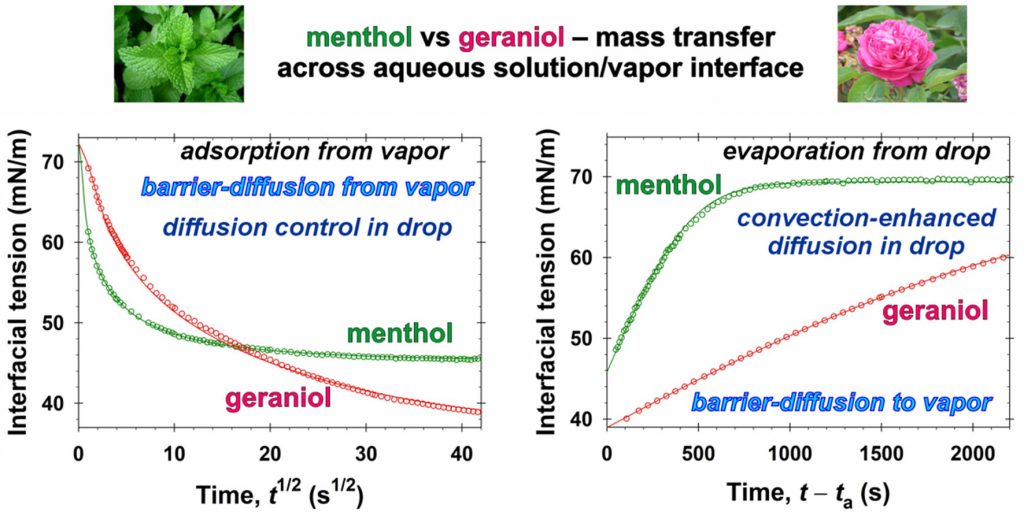
Salt-induced gelation of nonionic sucrose ester dispersions
J. Colloid Interface Sci. 2025, 693, 137610
Hypothesis
The dispersions of nonionic sucrose ester surfactants in water exhibit a highly negative zeta-potential, though its origin remains controversial. The addition of electrolytes to these dispersions may influence their zeta-potential, thus potentially affecting their physicochemical properties.
Experiments
The electrolyte- and pH- driven gelation of aqueous dispersions of commercial sucrose stearate (S970) containing ca. 1:1 monoesters and diesters was studied using optical microscopy, rheological and zeta-potential measurements, and small-angle X-ray scattering techniques.
Findings
At low electrolyte concentrations and pH ≳ 5, 0.5–5 wt% S970 dispersions exhibited low viscosities and behaved as freely flowing liquids. The addition of electrolytes of low concentrations, e.g. 9 mM NaCl or 1.5 mM MgCl2, induced the formation of a non-flowing gels. This sol–gel transition occurred due to the partial screening of the diesters particles charge, allowing the formation of an attractive gel network, spanning across the dispersion volume. Complete charge screening, however, led to a gel-sol transition and phase separation. Gel formation was observed also by pH variation without electrolyte addition, whereas the addition of free fatty acids had negligible impact on dispersion properties. These findings support the hypothesis that the negative charge in sucrose ester dispersions arises from hydroxyl anions adsorption on particles surfaces. Gels were formed using just 1.3 wt% surfactant, and the critical electrolyte concentration for gelation was found to scale approximately with the square of the cation charge, in agreement with the low surface charge density theory. The biodegradable sucrose esters gels offer a sustainable alternative for structuring personal and home care products, replacing the wormlike micelles of synthetic surfactants typically used at much higher surfactant and salt concentrations.
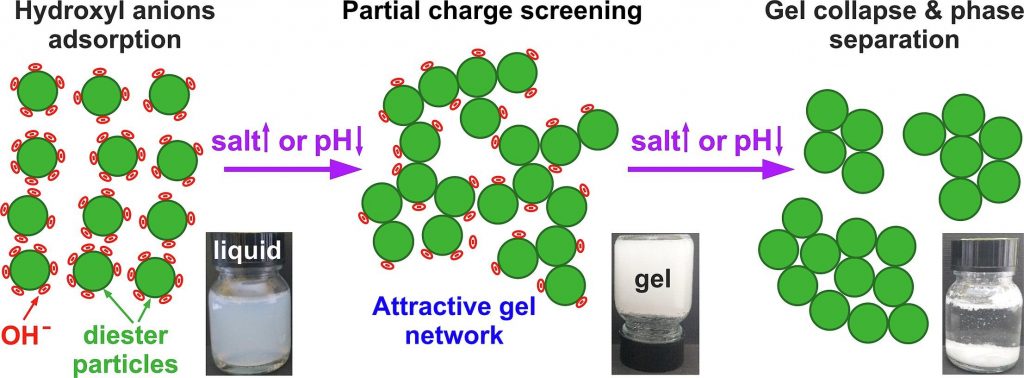
Role of dispersion nanostructure for bubble dissolution under pressure
Colloids Surf. A 2025, 712, 136443
Understanding the factors that affect bubble dissolution under pressure is crucial for the pneumatic transport of dispersions. This study probes the kinetics of air dissolution, the air solubility at a given pressure, and the gas diffusion due to bubble dissolution to elucidate the molecular mechanisms of gas transport in liquid dispersions with varied structures and viscosities. We achieve our aims by using water-glycerol mixtures, silicone oils with different viscosities, surfactant solutions containing worm-like micelles and having different macroscopic viscosities, particle suspensions, and surfactant solutions capable of forming a condensed adsorption layer on the bubble surfaces at ambient conditions. The results show that the dissolution rate does not depend on the macroscopic viscosity for silicone oils and solutions containing worm-like micelles, indicating that gas diffusion occurs faster than the movement of big polymeric molecules and worm-like micelles. We could predict the experimentally determined diffusion coefficients by accounting for free volume in these media and using the equation for Knudsen diffusion. We show that one way to decrease the rate of bubble dissolution under pressure is to add surfactants, which can decrease the permeability of the adsorption layer formed on the bubble surface by forming a condensed adsorption layer.
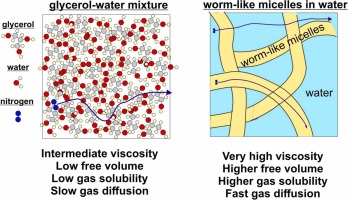
Hydroxypropyl cellulose polymers as efficient emulsion stabilizers: The effect of molecular weight and overlap concentration
Gels 2025, 11, 113
Hydroxypropyl cellulose (HPC) is a non-digestible water-soluble polysaccharide used in various food, cosmetic, and pharmaceutical applications. In the current study, the aqueous solutions of six HPC grades, with molecular mass ranging from 40 to 870 kDa, were characterized with respect to their precipitation temperatures, interfacial tensions (IFTs), rheological properties and emulsifying and stabilization ability in palm (PO) and sunflower (SFO) oil emulsions. The main conclusions from the obtained results are as follows: (1) Emulsion drop size follows a master curve as a function of HPC concentration for all studied polymers, indicating that polymer molecular mass and solution viscosity have a secondary effect, while the primary effect is the fraction of surface-active molecules, estimated to be around 1–2% for all polymers. (2) Stable emulsions were obtained only with HPC polymers with Mw ≥ 400 kDa at concentrations approximately 3.5 times higher than the critical overlap concentration, c*. At PO concentrations beyond 40 wt. % or when the temperature was 25 °C, these emulsions appeared as highly viscous liquids or non-flowing gels. (3) HPC polymers with Mw < 90 kDa were unable to form stable emulsions, as the surface-active molecules cannot provide steric stabilization even at c ≳ 4–5 c*, resulting in drop creaming and coalescence during storage.
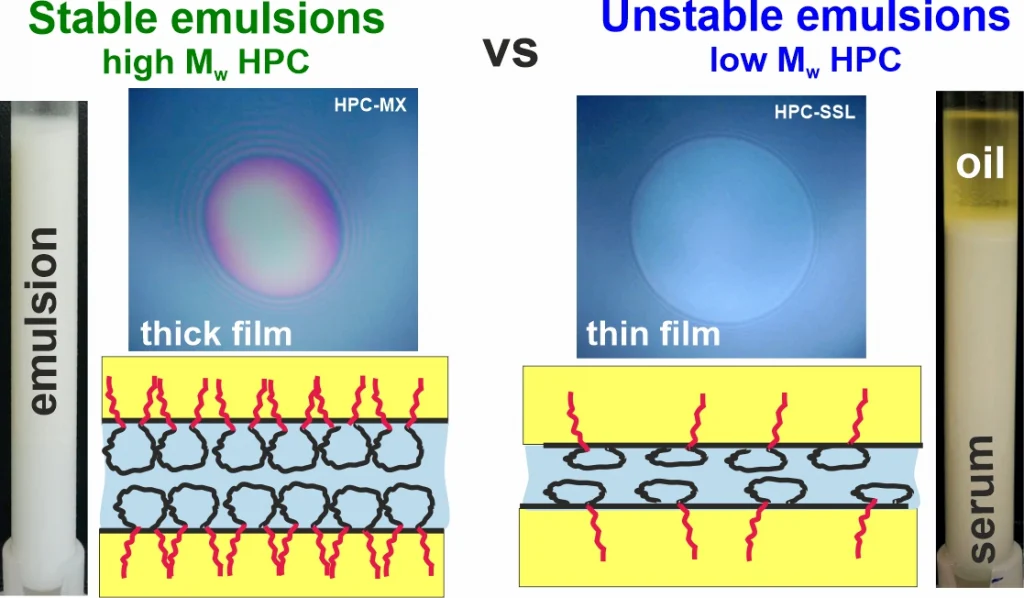
Rheology of dispersions containing non-spherical lipid particles
Colloids Surf. A 2025, 710, 136284
The rheological properties of disperse systems play a crucial role in the production of foods, cosmetics, and pharmaceuticals with desired characteristics. Emulsion viscosity can be increased through various methods, incl. increasing the oil volume fraction, incorporating rheological modifiers, or inducing partial coalescence between the droplets. It is well known that suspensions containing inorganic non-spherical particles often exhibit significantly higher viscosities when compared to those with spherical particles. The spontaneous drop self-shaping phenomenon in emulsions, first reported in detail by Denkov et al. (Nature, 2015, 528, 392–395), enables the formation of fluid and frozen lipid particles with regular non-spherical shapes, including platelets, rods and fibers. In this study, we utilize this approach to prepare emulsions containing non-spherical frozen particles of various shapes and investigate their rheological properties. The effects of oil volume fraction, surfactant type, initial drop size and polydispersity are investigated. The results reveal that non-flowing, gel-like samples can be prepared at ca. 11 vol% oil fraction when the emulsion contains polydisperse droplets which acquire non-spherical shapes upon cooling. For comparison, more than ca. 65 vol% oil is needed to obtain similar rheological characteristics in samples containing spherical particles. Additionally, we demonstrate that the optimal drop size for gel preparation is d32 ≈ 4–13 μm. The obtained results are explained mechanistically, and guiding principles are provided for preparing emulsions with increased viscosities using this new approach.

Reexamining the enhanced solubility of sodium laurate/sodium oleate eutectic mixtures
Langmuir 2025, 41, 1568-1576
Mixtures of multiple surfactants that have superior performance to the individual components are highly sought-after commercially. Mixtures with a reduced Krafft point (TK) are particularly useful as they enable applications at lower temperatures. Such an example is the soap maker’s eutectic: the mixture of sodium laurate (NaL) and sodium oleate (NaOl). A true eutectic implies that the two surfactants do not mix in the solid state but mix readily in the micellar solution above TK, leading to a sharp TK depression at a specific composition. However, the NaL/NaOl mixture shows a broad TK depression of >15 °C at a NaOl weight fraction (wO) of about 0.5. Our tie-line analysis shows that pure NaL and NaOl do not coexist in the solid phase on either side of the TK minimum. X-ray analysis of the isolated solids with varying wO reveals that a unique intermediate compound (I.C.) forms in the solid state with a NaL-to-NaOl mole ratio of about 4/3. Below the TK minimum, NaL and the I.C. coexist in the solids for wO 0.5. Each pair of solids exhibits eutectic or monotectic solubility behavior, and the congruent I.C. melting point is so close to that of the eutectic point(s) that a broad TK minimum ensues. Thermal analysis and modeling via the freezing-point depression approach support the above interpretation. The fact that surfactants with other headgroups but the same blend of chain lengths do not exhibit similar depressed TK is a topic for further study.
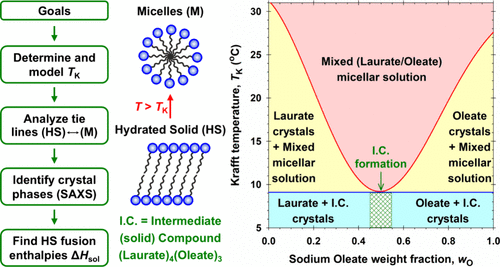
Spontaneous bubble growth inside high-saturation-vapor-pressure and high-air-solubility liquids and emulsion droplets
Langmuir 2025, 41, 2071-2081
Spontaneous bubble growths in liquids are usually triggered by rapid changes in pressure or temperature that can lead to liquid gas supersaturation. Here, we report alternative scenarios of the spontaneous growths of bubbles inside a high-saturation-vapor-pressure and high-air-solubility perfluorocarbon liquid (PP1) that were observed under ambient quiescent conditions. First, we investigate spontaneous bubble growth inside the single PP1 phase, which was left to evaporate freely. The bubble growth is explained by the difference in the PP1 vapor pressure inside the bubble and that above the freely evaporating PP1 interface. Next, we study the bubble growth inside the liquid PP1 covered with a layer of a second air-saturated immiscible liquid: low-air-solubility water or higher-air-solubility ethanol. In both cases, the bubble growth rates were accelerated, indicating mass transfer of air from the water or ethanol phases to the PP1 phase. The bubble growth rates significantly increase for bubbles trapped at the PP1–water or PP1–ethanol interfaces due to faster air diffusion through the thin PP1 liquid films separating the bubbles from the upper phases. Finally, we consider the case of bubbles inside millimeter-sized PP1 emulsion droplets in water or ethanol. The bubble growth inside the droplet leads to an increase in the PP1 droplet’s effective buoyancy and to the detachment of the droplets from the substrate. The observed bubble growth rate in the case of emulsion droplets was much faster for PP1 droplets in ethanol than for PP1 droplets in water (minutes vs hours). The underlying physical mechanism of the increase of bubble volumes is the spontaneous mass transfer of both air and PP1 vapor to the bubbles produced by a colloidal diffusion pump effect.
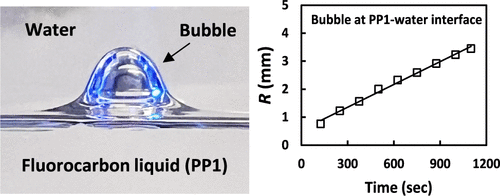
Bouncing bubbles do not show water slip on smooth hydrophobic surfaces
J. Colloid Interface Sci. 2025, 683, 274-280
Hypothesis: The presence of hydrodynamic slip of water on smooth hydrophobic surfaces has been debated
intensely over the last decades. In recent experiments, the stronger bounce of free-rising bubbles from smooth
hydrophobic surfaces compared to smooth hydrophilic surfaces was interpreted as evidence for a significant
water slip on smooth hydrophobic surfaces.
Experiments: To examine the possible water-slip effect, we conduct well-controlled experiments comparing the
bouncing dynamics of millimeter-sized free-rising bubbles from smooth hydrophobic and hydrophilic surfaces.
The hydrophobic surfaces were graphite or Teflon, and the hydrophilic surfaces were glass or mica. To avoid
contamination, the experiments were conducted in pure water without any surface-active additives. Numerical
simulations were also used to compare the bounce of the bubble from a no-slip and free-slip walls.
Finding: Our experiments show that the free-rising bubbles in pure water bounce identically from the smooth
hydrophobic graphite or Teflon surfaces as from smooth hydrophilic mica or glass surfaces. The bubble bounce
from all four surfaces is in excellent agreement with the numerical simulation of a bubble bouncing from a flat,
no-slip wall. At the same time, numerical simulations for bubbles bouncing from a free-slip wall predict up to
two-fold stronger bouncing amplitudes. Our experiments and numerical simulations, including estimates of the
shear rates, confirm the no-slip boundary condition for water on smooth hydrophobic surfaces.
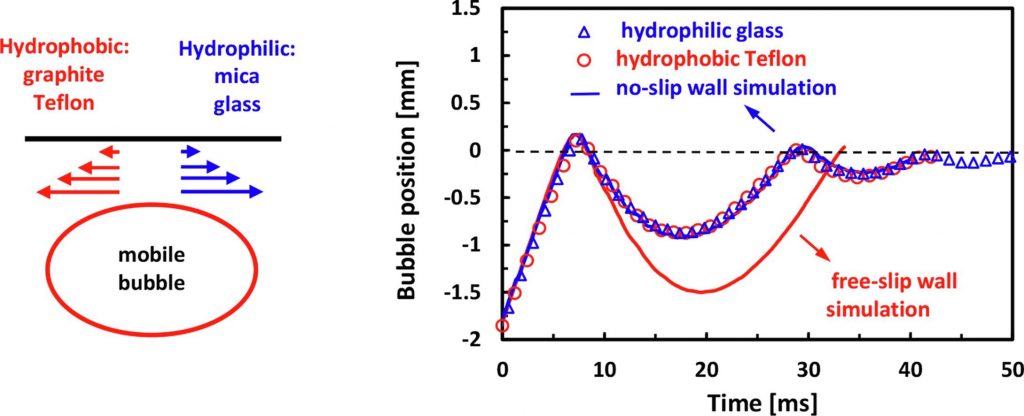
ISCOM-type matrix from beta-escin and glycyrrhizin saponins
Heliyon 2025, 11, e41935
Background and aims
Nanotechnology provides the opportunity for construction of modern transport devices such as nanoparticles for a variety of applications in the field of medicine. A novel experimental protocol for the formation of saponin-cholesterol-phospholipid nanoparticles of vesicular structure has been developed and applied to prepare stable nanoparticles using escin or glycyrrhizin as saponins.
Methods
The methods for nanoparticle construction include a sonication at 90 °C of the initial mixture of components, followed by an additional sonication on the next day for incorporation of an additional amount of cholesterol, thus forming stable unilamellar vesicles. Tests and assays for cell viability, erythrocyte hemolysis, flow cytometry, and fluorescent microscopy analyses have been performed.
Results
By selecting appropriate component ratios, stable and safe particles were formulated with respect to the tested bio-cells. The prepared nanoparticles have mean diameter between 70 and 130 nm, depending on their composition. The versatility of these nanoparticles allows for the encapsulation of various molecules, either within the vesicle interior for water-soluble components or within the vesicle walls for hydrophobic components. The saponin particles formed after cholesterol post-addition (E3-M2) are stable and 100 % of the cells remain viable even after 10-times dilution of the initial particle suspension. These particles are successful included into isolated mouse macrophages.
Conclusions
Among the variety of generated nanoparticles, the E3-M2 particles demonstrated properties of safe and efficient devices for future vaccine design and antigen targeting to immune system.

Understanding drug solubilization in intestinal mixed micelles through molecular dynamics simulations
J. Colloid Interface Sci. 2025, 684, 225-234
Hypothesis
Solubilization is a fundamental process that underpins various technologies in the pharmaceutical and chemical industry. However, knowledge of the location, orientation and interactions of solubilized molecules in the micelles is still limited. We expect all-atom molecular dynamics simulations to improve the molecular-level understanding of solubilization and to enable its in silico prediction.
Methods
The solubilization of six drugs in intestinal mixed micelles composed of taurocholate and dioleoyl phosphatidylcholine was simulated by molecular dynamics in explicit water and measured experimentally by liquid chromatography. The location and orientation of the solubilized drugs were visualized by cumulative radial distribution functions and interactions were characterized by radial distribution function ratios and hydrogen bonding.
Findings
A new simulation-derived parameter was defined, which accounts for drug-micelle and drug-water interactions and correlates (R2 = 0.83) with the experimentally measured solubilization. Lipophilicity was found to govern the location of all drugs in the micelle (hydrophobic core, palisade layer or on the surface), while hydrogen bonding was crucial for orientation and solubilization of two of the molecules. The study demonstrates that explicit, hydrogen bond-forming water molecules are vital for accurate prediction of solubilization and provides a comprehensive framework for quantitative studies of drug location and orientation within the micelles.
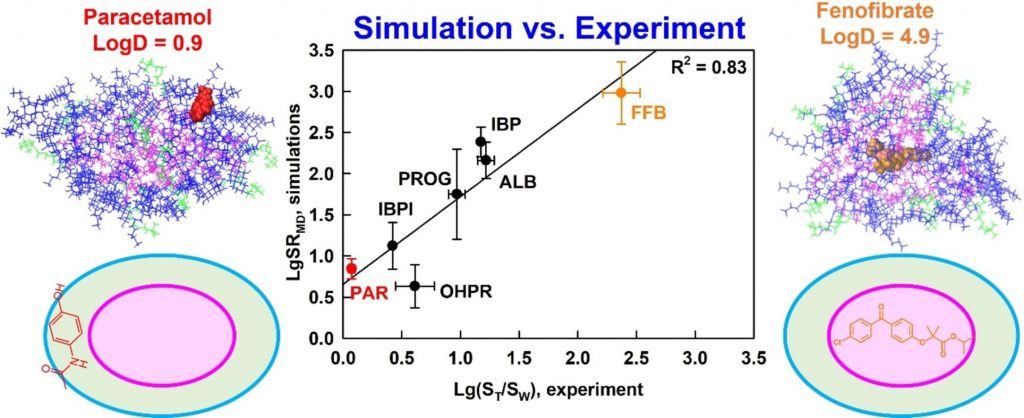
Interplay between cosurfactants and electrolytes for worm-like micelles formation
Colloids Surf. A 2025, 707, 135943
The rheological response of surfactant solutions containing a mixture of anionic and zwitterionic surfactants, in the presence of shorter-chain cationic and nonionic co-surfactants and various counterions was studied experimentally and described theoretically by developing the model that accounts for the competitive adsorption of different monovalent and divalent counterions, as well as the inclusion of co-surfactants within the micelles. This model was used to predict the salt curve dependence of systems with various salt and co-surfactant concentrations and was tested against the experimentally measured salt curves. A good agreement was found between the experimental data and the proposed theoretical model. It was demonstrated that the adsorption energies of counterions on the micellar surfaces remain unchanged with the addition of co-surfactants. However, the conditions for micelle branching are significantly affected, particularly in the presence of divalent and trivalent counterions. The presence of co-surfactants reduces the number of adsorbed divalent ions, thereby diminishing their effect on micelle branching.
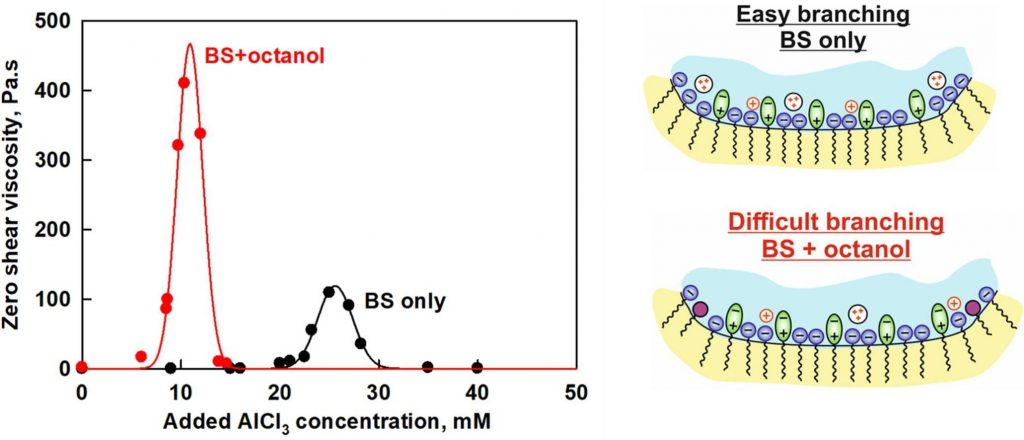
Emulsification in nearly Newtonian and non-Newtonian media of wormlike micelles
Colloids Surf. A 2025, 705, 135603
Emulsification experiments with four silicone oils, having viscosities ranging from 0.01 to 30 Pa.s, were conducted in two types of media: nearly Newtonian polyvinyl alcohol (PVA) solutions and non-Newtonian mixtures induced by worm-like micelles in solutions of sodium laureth sulfate and cocoamidopropyl betaine (BS) with NaCl. The increased viscosity of BS solutions upon the addition of NaCl did not significantly affect the drop size in the formed emulsions. In contrast, the increased viscosity of solutions with higher PVA concentrations significantly reduced the drop sizes for all silicone oils. A theoretical expression predicting the maximum drop size in both types of media (nearly Newtonian and non-Newtonian) was derived and validated against experimental data. The expression accounts for shear-thinning behavior in both the aqueous and oil phases. Interfacial stress dominates the breakage of less viscous oils, while viscous stress inside the breaking drop plays a leading role for more viscous oils. The formation of emulsions with similar sizes in non-Newtonian solutions of BS with different NaCl concentrations was explained by their strongly shear-thinning behavior, which leads to nearly similar viscosity at high shear rates, despite their zero-shear viscosities differing by more than two orders of magnitude.
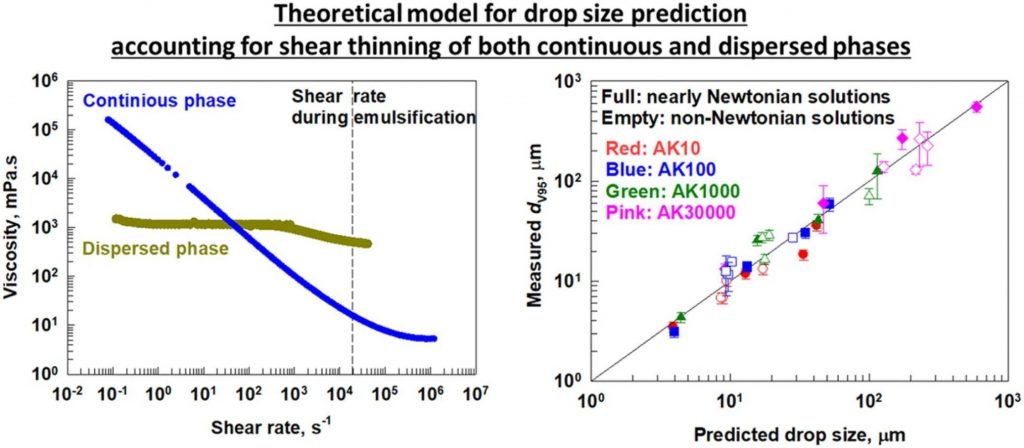
Colloid, interface, and foam properties of water-soluble polyglycerol esters solutions
J. Colloid Interface Sci. 2025, 677, 250-263
Hypothesis
Polyglycerol esters of fatty acids are generated via the esterification of a polydisperse mixture of polyglycerol with naturally derived fatty acids. The polymerization process of polyglycerol results in the production of various oligomers, ranging from di-, tri-, and higher-order forms, which contribute to the complexity of final products. The combination of complementary experimental techniques and adequate theoretical interpretations can reveal the wide variety of their physicochemical properties.
Experiments
The colloid and interface properties of polyglyceryl mono-laurate, mono-stearate, mono-oleate, and a mixture of mono-caprylate and mono-caprate esters solutions were characterized by measurements of the electrolytic conductivity, static and dynamic surface tension, aggregate and micelle sizes and distributions, thin liquid film stability and stratification, and solubility in aqueous and in oil phases. The formation, stability, and bubble size distribution of foams generated from polyglycerol esters aqueous solutions were systematically investigated.
Findings
The low concentrations of double-tail molecules and fatty acids in polyglycerol esters affect considerably their micellar, aggregation, and vesicle formations in aqueous solutions. The theoretical data interpretation of polyglycerol esters isotherms and thin liquid films data provide information on the adsorption energies, excluded areas per molecule, interaction parameters of molecules at interfaces, surface electrostatic potential, and the size of micelles. Polyglyceryl mono-oleate exhibits spontaneous emulsification properties. Short chain length polyglycerol esters have excellent foaming ability but relatively low foam stability. The optimal weight fractions of the short-chain polyglyceryl esters and polyglyceryl mono-stearate mixtures with respect to good foaminess and foam stability upon Ostwald ripening are obtained. The reported physicochemical characterization of the water-soluble polyglycerol esters could be of interest to increase the range of their applicability in practice.
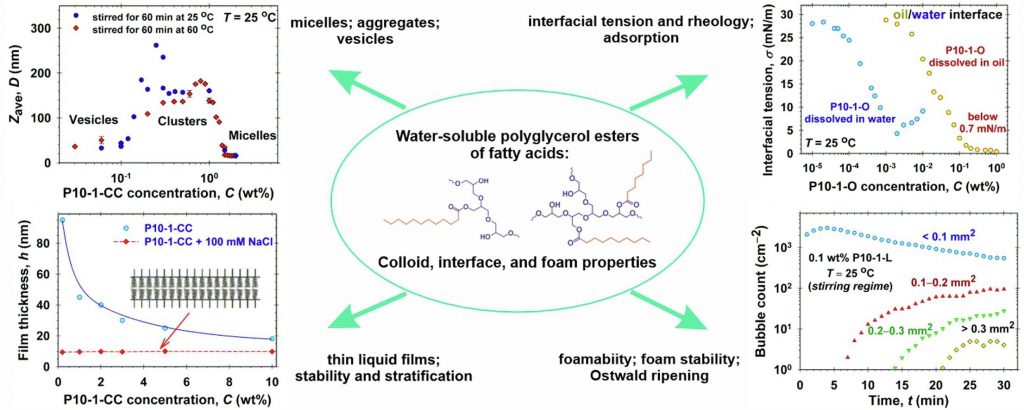
Design and development of a multi-epitope vaccine prototype against SARS-CoV-2
European Journal of Immunology, 7th European Conference of Immunology, 1–4 September, 2024, Dublin, Ireland 2024, 54, 1433
Purpose: SARS-CoV-2 caused COVID-19 pandemic overwhelms global health care. COVID-19 vaccination is crucialfor preventing infection and controlling the pandemic. Multiple safe and effective vaccines are available worldwide.Nanotechnology provides the opportunity for construction of modern transport devices such as nanoparticles for a varietyof applications in the field of medicine. A novel experimental protocol for the formation of saponin-cholesterol-phospholipid nanoparticles of vesicular structure has been developed and applied to prepare stable nanoparticles usingescin or glycyrrhizin as saponin.Here, we describe the design and development of a next-generation multi-epitope vaccine for SARS-CoV-2, consistingof epitopes recognizable by T-cells.Methods: Structure-based and sequence-based immunoinformatics methods were used to derive models for selection ofMHC binders specific for the mouse strain used in the study among a set of human SARS-CoV-2 T-cell epitopes identifiedby convalescent patients with COVID-19. The binders were synthesized and included in a multi-epitope vaccineprototype.The methods for nanoparticle construction include a sonication, thus forming stable unilamellar vesicles. Tests and assaysfor cell viability, erythrocyte hemolysis, flow cytometry, and fluorescent microscopy analyses have been performed.Results: The immunogenicity of the vaccine prototype designed in the present study was tested on humanized-ACE2transgenic B6.Cg-Tg(K18-ACE2)2Prlmn/J mice by in vitro, in vivo, and ex vivo immunoassays. The animals wereimmunized with a mix of predicted MHC-I, or MHC-II, or MHC-I/MHC-II peptide epitopes in CFA, and boosted withpeptides in IFA. Immunization with SARS-Cov-2 epitopes remodels lymphocyte profile. A weak humoral response andsignificant production of IL-4 and IFN-γ from T cells were found after vaccination of the animals.By selecting appropriate component ratios, stable and safe particles were formulated with respect to the tested bio-cells.The versatility of these nanoparticles allows for the encapsulation of various molecules, either within the vesicle interiorfor water-soluble components or within the vesicle walls for hydrophobic components. These particles are successfulincluded into isolated mouse macrophages.Conclusion: The multi-epitope vaccine prototype presented in this study demonstrates immunogenicity in mice andshows potential for human vaccine construction.This work was supported by the Bulgarian Science Fund (Grant No KP-06-DK1/2/2021).
Polymorphism in triglyceride systems: in bulk and in emulsion droplets
Acta Crystallographica Section A Foundations and Advances 2024, 80, e660-e660
Leidenfrost spheres, projectiles, and model boats: Assessing the drag reduction by superhydrophobic surfaces
Colloids Surf. A 2024, 699, 134573
Superhydrophobic surfaces are expected to reduce drag on bluff bodies moving in water due to the introduction
of a thin air layer around the solid and the resulting partial slip boundary condition. The use of Leidenfrost vapor
layers, sustained on the surface of a heated metal body is a reliable method to estimate the maximum drag
reduction possible due to such air layers. In the past such an approach was used to estimate the drag reduction on
a free-falling heated sphere, in which case the form drag is the lead component of the drag force. Here, we extend
this approach to evaluate the effect of the thin gas layers on the hydrodynamic drag of free-falling streamlined
projectiles and towed model boats, where the form drag is minimal, and the skin friction drag is the lead
component of the drag force. By comparing the drag for streamlined bodies with and without sustained airlayers, we see only incremental drag reductions, for the sub-critical Reynolds number tested herein. The same
is true for towed model boats. These results hold both for superhydrophobic surface treatments and Leidenfrost
vapor layers. Thus, we concluded that for the investigated range of sub-critical Reynolds numbers, the skin
friction drag is less sensitive to the effect of the thin gas layers compared to the form drag. These novel findings
have important implications for the practical potential of energy savings using gas layers sustained on super
hydrophobic surfaces.
